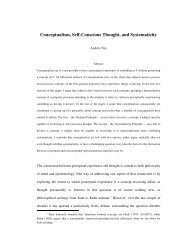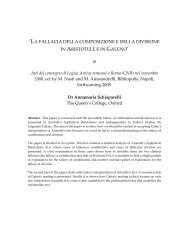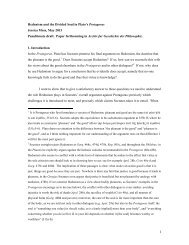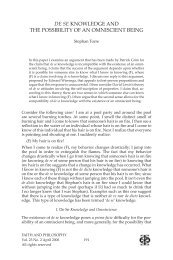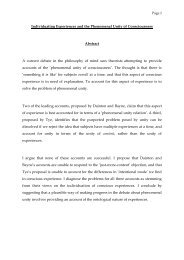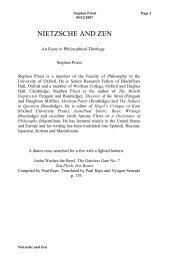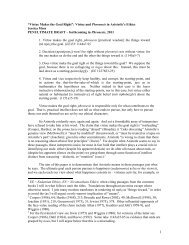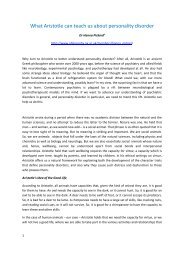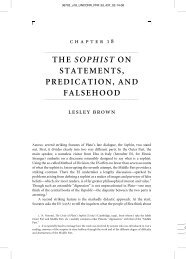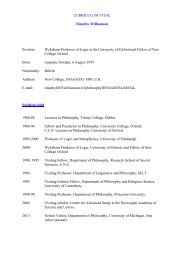In 'Assertion', Robert Stalnaker distinguishes between the sema
In 'Assertion', Robert Stalnaker distinguishes between the sema
In 'Assertion', Robert Stalnaker distinguishes between the sema
Create successful ePaper yourself
Turn your PDF publications into a flip-book with our unique Google optimized e-Paper software.
indeed by merely appealing to general principles of rational communication. They are to<br />
be explained by specific conventional details regarding certain kinds of constructions: use<br />
of a deictic expression requires that <strong>the</strong> referent be already salient to <strong>the</strong> audience,<br />
whereas use of a definite description does not. <strong>In</strong> sum, <strong>the</strong>re is no general principle<br />
governing conversation approximated by Weak Uniformity, and cases of assertoric<br />
infelicity tied to ‘not knowing who or what is being talked about’ are to be explained by<br />
fine-grained principles governing referential devices, not general principles about rational<br />
communication.<br />
We turn to a second challenge, one that turns on more foundational issues. It is important<br />
to <strong>Stalnaker</strong> that, in a given setting, we (i) represent someone’s cognitive state simply by<br />
which propositions he or she accepts or rejects and (ii) we think of propositions in a<br />
coarse grained way, as sets of possible worlds. He wants, as a <strong>the</strong>orist, to represent<br />
ignorance about whe<strong>the</strong>r Bill or Ben is in <strong>the</strong> room by context set that includes some Billin-<strong>the</strong>-room<br />
worlds and some Ben-in-<strong>the</strong>-room worlds. <strong>In</strong>tuitively, that ignorance persists<br />
after ‘He is on fire’ has been uttered. So if we represent ignorance in <strong>the</strong> way prescribed,<br />
it seems that we should, as <strong>the</strong>orists, represent <strong>the</strong> post-assertion context set as including<br />
some Bill-in-<strong>the</strong>-room worlds and some Ben-in-<strong>the</strong>-room worlds. But if this is right, <strong>the</strong>n<br />
we cannot represent <strong>the</strong> update as <strong>the</strong> result of intersecting <strong>the</strong> <strong>sema</strong>ntic content with <strong>the</strong><br />
original context set – for that would knock out all <strong>the</strong> Ben worlds. <strong>In</strong> sum, <strong>Stalnaker</strong><br />
insists on coarse-grained contents and insists on using contents ra<strong>the</strong>r than, say,<br />
guise/content pairs as <strong>the</strong> means of representing intuitive facts about ignorance. This puts<br />
severe constraints on which contents can be ascribed to thinkers in a particular<br />
explanatory context.<br />
We recognize that such a perspective might lead one to have reservations about our rough<br />
and ready toy account. Certainly, our aim in discussing <strong>the</strong> second challenge is largely to<br />
show how uniformity connects to broader issues and not to resolve <strong>the</strong> latter. But one<br />
conclusion of <strong>the</strong> preceding discussion does bear emphasis. We have argued that<br />
<strong>Stalnaker</strong> cannot respect all <strong>the</strong> constraints that he places on himself. True enough, those<br />
constraints flow from his desire to represent ignorance using coarse grained contents – he<br />
2



